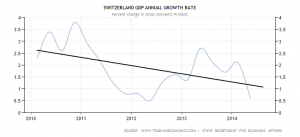Gold and silver rebound significantly after taking a beating in Sunday trade.
 Bullion.Directory precious metals analysis 1 December, 2014
Bullion.Directory precious metals analysis 1 December, 2014
By Christopher Lemieux
Senior FX and Commodities Analyst at FX Analytics
In what was likely correlated to 78 percent of Swiss voters okaying franc devaluation via the Swiss National Bank (SNB), gold and silver sold over sharply when markets opened for trade on Sunday. Computer algorithms were largely responsible for the large decline in the precious metals complex on news that Swiss voters said “no” to the gold referendum, essentially giving the SNB a free pass on quasi-monetary policy.
The SNB was the biggest winner on the outcome, which saves the central bank from purchasing roughly 72 billion CHF in gold over the next five years. However, gold and silver saw large demand near the session lows. Round trip, gold is up over $50 from session lows; silver up over $2 from a new multi-year low.
The Swiss gold vote turned out as expected after the SNB’s rhetoric was borderline fear mongering. SNB Governor Thomas Jordan indicated that forcing the central bank to buy gold would wreck economic growth and pose difficulty for the bank to continue its 1.20 EURCHF pegged rate. Unfortunately for Jordan, Switzerland’s growth expansion since the FX peg three years ago has been lackluster.
The SNB dodged a bullet, a large bullet.
Gold, also, received bids after a series of disappointing manufacturing PMI data from around the globe.
The HSBC Chinese manufacturing PMI came inline with expectations at 50. China’s manufacturing sector is teetering on contracting and reaching the lowest level since March.
All five sub-categories declined with new export orders leading the way, carving out a new 17-month low. Small and medium-sized manufacturers are sliding deeper into contraction, 47.6 and 48.4 respectively. The steel industry collapses to 43.3. Unfortunately, bad news is good news. Analysts expect more stimulus from the People’s Bank of China.
Germany, once eurozone’s powerhouse, saw manufacturing fall into contraction. After printing a 49.5, Germany’s manufacturing PMI hit levels not seen since June 2013. French and Italian manufacturing PMI data still indicates both are in contraction. The EZ manufacturing PMI figure is just .2 away from contraction.
Italy continues to disappoint with GDP contracting .5 percent in the third-quarter.
The US manufacturing PMI fell to a 10-month low. This marks the fifth of six prints to miss the mark. Financial information provider Markit said “the principle cause of the slowdown is a renewed downturn in export orders, which fell for the first time since January.” Oddly enough, the Institute of Supply Management (ISM) manufacturing PMI actually increased and beat expectations on an increase in… new export orders. Go figure.
US manufacturing prices collapsed from 53.5 to 44.5. Markit mentioned some rather dire warnings to the recovery bulls:
What’s more, with inflows of new orders slowing sharply, there’s a good chance that production growth will deteriorate further in December.
Unless order book growth picks up, factories will inevitably soon turn to cutting jobs in order to bring capacity down in line with weaker demand.
So, the US is on the verge loosing higher-paying jobs that will likely turn into more waiters and bartenders. So much for a recovery.
Bullion.Directory or anyone involved with Bullion.Directory will not accept any liability for loss or damage as a result of reliance on the information including data, quotes, charts and buy/sell signals contained within this website. Please be fully informed regarding the risks and costs associated with trading in precious metals. Bullion.Directory advises you to always consult with a qualified and registered specialist advisor before investing in precious metals.













 Material provided on the Bullion.Directory website is strictly for informational purposes only. The content is developed from sources believed to be providing accurate information. No information on this website is intended as investment, tax or legal advice and must not be relied upon as such. Please consult legal or tax professionals for specific information regarding your individual situation. Precious metals carry risk and investors requiring advice should always consult a properly qualified advisor. Bullion.Directory, it's staff or affiliates do not accept any liability for loss, damages, or loss of profit resulting from readers investment decisions.
Material provided on the Bullion.Directory website is strictly for informational purposes only. The content is developed from sources believed to be providing accurate information. No information on this website is intended as investment, tax or legal advice and must not be relied upon as such. Please consult legal or tax professionals for specific information regarding your individual situation. Precious metals carry risk and investors requiring advice should always consult a properly qualified advisor. Bullion.Directory, it's staff or affiliates do not accept any liability for loss, damages, or loss of profit resulting from readers investment decisions.

Leave a Reply